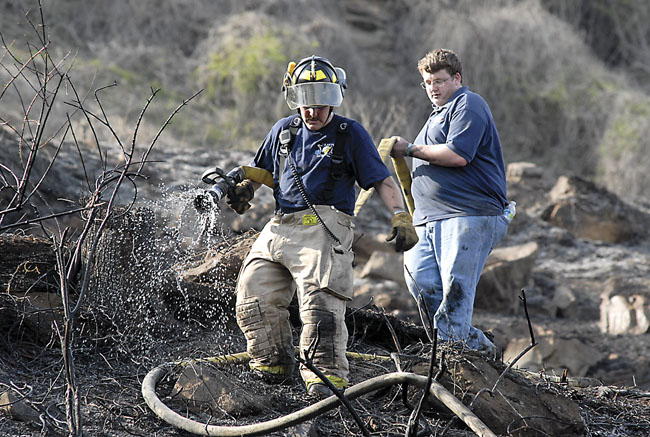Wildfire danger rises as spring approaches
Thursday, March 17, 2011
 Rick Brenner, left, of the Dallas Bay Volunteer Fire Department, and Matt Schmissrauter, of Walden's Ridge Emergency Service, carry a hose back down a steep slope after working to control a brush fire below the brow of Signal Mountain on Monday afternoon.
Staff Photo by John Rawlston/Chattanooga Times Free Press
Rick Brenner, left, of the Dallas Bay Volunteer Fire Department, and Matt Schmissrauter, of Walden's Ridge Emergency Service, carry a hose back down a steep slope after working to control a brush fire below the brow of Signal Mountain on Monday afternoon.
Staff Photo by John Rawlston/Chattanooga Times Free PressBy Randall Dickerson
NASHVILLE - As spring blossoms in Tennessee, so does the potential for wildfires.
The spring fire season, prompted by warming weather, began Feb. 15 and ends about May 15. And as spring begins, there are sections of Tennessee that are in the grip of drought.
"A lot of times, it's people burning debris and there are arsons, too," said Danny Osborne, the state Forestry Division area forester in Elizabethton, "Some are caused by lightning strikes, but most of our fires are human caused, one way or another."
The National Oceanographic and Atmospheric Administration Drought Monitor shows Tennessee counties along the Georgia, Alabama and Mississippi borders have moderate drought conditions. Those extend through Memphis and partway up the Mississippi River Valley. The remainder of West Tennessee and the northwestern part of Middle Tennessee are listed as abnormally dry.
The National Weather Services' spring outlook, however, calls for sufficient rain that the dry conditions are likely to improve.
Outdoor burning permits are required from Oct. 15-May 15.
Nathan Waters, assistant forester for the East Tennessee District, said each area of the state has its unique firefighting challenges. In his district, it's the steep terrain. The leaves of summer are a welcome sight.
"As the forest greens up, it holds the moisture in," Waters said. "If the (leaf) canopy is healthy, it shades the forest floor, blocks the wind and helps keep conditions on the ground moist."
One of the worst situations is when a persistent drought dries out the organic layer, called duff, that lies beneath the fallen leaves and dead grass. If that ignites, firefighters are dealing with an underground blaze, Waters said.
Wildfires in mountainous East Tennessee usually consume more forest, said Chris Ellis, the area forester in LaFollette.
"A 10-acre fire can become an 80- to 90-acre fire because you have to back off to where a bulldozer can be used," he said.
The typical manner of fighting wildfires is to cut a fire line around them, ideally with heavy equipment, to cut off the fuel they would otherwise consume to expand.
But sometimes, it comes down to grunt work by fire crews, Osborne said.
"We have fire rakes, shovels and chain saws and cut fire lines around them (by hand), he said.
The Forestry Division is part of the Tennessee Department of Agriculture.
Division spokesman Tim Phelps said 2010 was a bit below the five-year average for the number of wildfires statewide.
"Last year, 20,000 acres burned, with a total of 1,671 fires," he said.
The last bad year for wildfires in Tennessee was 2007.
"We had that late spring frost that killed the leaves on the trees, followed by a very severe drought," Phelps said.
That year, 44,000 acres burned.
So far in 2011, there have been 333 wildfires. Debris burning that got out of hand caused 158 of them, but the other 101 were determined to be arson cases. A total of 4,406 acres have burned.
Why would someone torch the woods? Phelps said some of the answers given by arson suspects are amazing.
"A man convicted of arson last year said he didn't like pine trees," Phelps said.
Asked to speculate on this spring's fire season, Phelps issued a cautious appraisal.
"It's always sort of a crystal ball, but we've had pretty good rainfall in much of the state," Phelps said. "But bright, sunny days, moderate temperatures and even light wind can dry out fuel pretty quickly."
